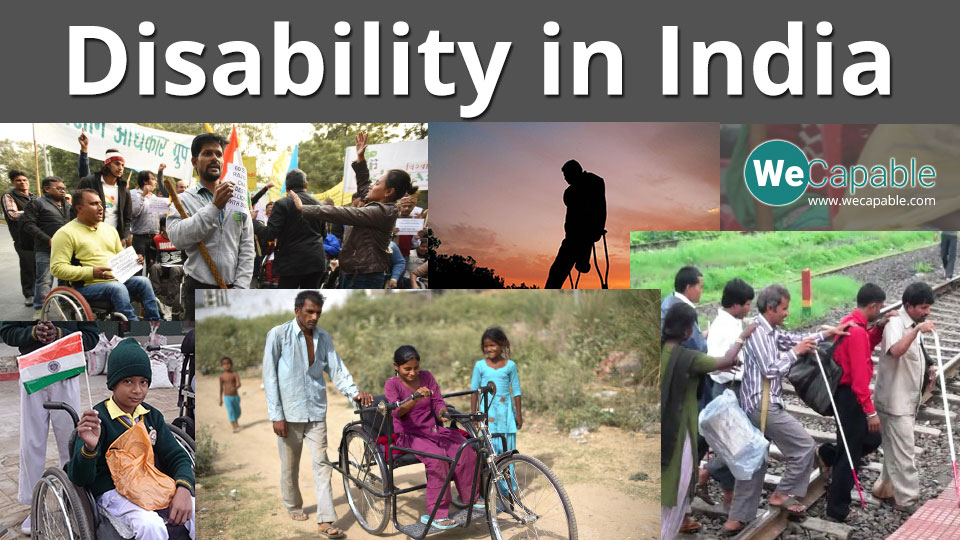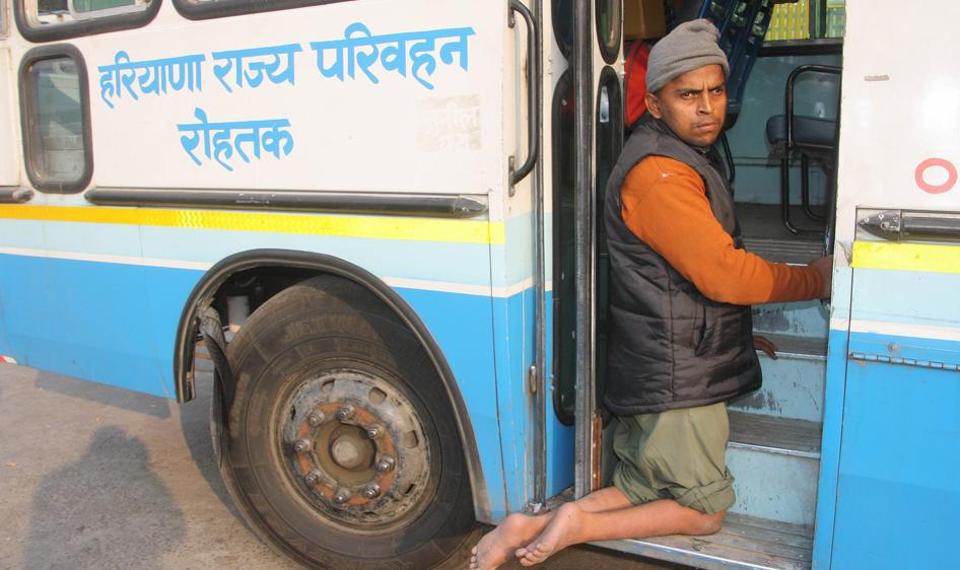As per the 2011 Census, 2.21% of Indian population has some type of disability. This makes about 2 crore 68 lakh (26.8 million) people. At present Indian government recognizes 21 types of disabilities. In India disability is generally seen as a repercussion of bad deeds of previous lives. A lot of other similar cliches are attached to disability in India. Generally, people with disabilities are seen with pity and considered almost useless.
Poverty, lack of disabled friendly infrastructure and inefficient implementation of welfare schemes are some of the major problems in context of disability in India. Employment for disabled people is also a huge issue as most of the disabled people fail to get a suitable job.
Disability in India: Some Facts
- More than 41% persons with disabilities in India never get married!
- Locomotor and multiple disabilities are more commonly found in rural areas of India.
- Speech and hearing impairment are found to be more prevalent among the urban population of India.
- Only 36.3% of the disabled population (which turns out to be about 98 lakhs) are employed.
- Of these, about 71 lakh are men and 27 lakh are women
- Literacy rate among women with disabilities is merely 45% whereas the overall women literacy rate in India is 65%.
- Literacy rate of men with disabilities is 62%.
- 27% of Indian people with no disability are illiterate. This figure goes up to 57% in case of people with intellectual disability.
- 44% of Indian people with no disability are unemployed. In contrast, 72% of people with intellectual disability remain unemployed.
- Only 8.5% disabled people in India acquire a graduate degree.
- It is estimated that the number of unemployed persons with disabilities will cross 10 million by 2022 if appropriate skills are not imparted through training programs.
- Ignoring the potential of disabled people can cost any nation very high. In case of India, leaving persons with disabilities out of economy translates into a loss of about 5-7% of GDP.
Disability in India: Country is a Signatory of UNCRPD
United Nations Convention on the Rights of Persons with Disabilities (UNCRPD) is an international treaty that aims to protect the rights and dignity of persons with disabilities. India signed UNCRPD on 30 March 2007 and ratified it on 01 October 2007. By ratifying UNCRPD, India became legally bound to enact laws for ensuring the equal opportunities for disabled persons in India.

Disability in India: The RPWD Act 2016
In response to the commitment made under UNCRPD, India enacted the Rights of Persons with Disabilities Act in 2016. This law came into force on 30 December 2016 and replaced the Persons with Disability (P.w.D.) Act that was enacted way back in 1995.
- According to the Act any person who “intentionally insults or intimidates with intent to humiliate a person with a disability in any place within public view” is punishable with imprisonment.
- To increase the job opportunities of persons with disabilities, the Act has increased the reservation quota from 3% to 4%. This means that 4% of all vacancies in the government organizations will be reserved for disabled people.
- Another very important feature of this Act is the provision of special courts in each district. These special courts will handle cases pertaining to the violation of the rights of P.w.D.
- A large number of children with disabilities do not get proper education in India. This act proposes that every child with disability gets free education from the age of 6 to 18.
- State Governments will constitute district-level committees to address the local issues of P.w.D.
- Office of Chief Commissioner and the Office of State Commissioners of Persons with Disabilities have been given more powers.
- Broad-based Central & State Advisory Boards on Disability are to be set up to serve as apex policy-making bodies at the Central and State level.
- Victims of acid attacks have been included in the list of P.w.D. Unfortunately, in India, acid attacks have been on the rise in last few years. Girls and women are often left severely disfigured/disabled due to such attacks.
- Dwarfism and Muscular Dystrophy have also been included as separate categories of disability.
- Three blood disorders, Thalassemia, Hemophilia and Sickle Cell disease, have been included in the list of disabilities.
- Number of types of disabilities have been increased from 7 to 21.
Disability in India: General Perceptions
- Disability is a consequence of deeds of previous lives (karmas)
- God or nature compensates a person with disability by giving some other super-ability
- God will help us if we will help a disabled person
- Persons with disabilities always need assistance and normal-bodied person are obliged to help them
- Accommodating workplace for workers with disability is too costly
- People with disabilities are inspirational and courageous therefore should be praised for whatever they do
READ ALSO: Common myths about Autism
Divyang: India’s New Term to Address Persons with Disabilities.
Divyang is a Hindi word meaning the one with a divine body. The current government said that the persons with disabilities should no longer be referred to as disabled persons or viklang. The word viklang is Hindi for someone with non-functional body parts. They should now be referred to as divyang or divyangjan. This new connotation of the word is absolutely unacceptable.
Society does not need to see disabled people as gods or demons. We just need to understand that disability is a circumstance that can affect anybody, anywhere, anytime. We need to work towards mitigating the effect of disability on a person’s life. No disabled person would want to have a status of a divine being — all they want is equal opportunities, accessible infrastructure and understanding from the society.
Disability in India: Bollywood and Disability
Hindi cinema, popularly known as Bollywood, has been portraying characters with disabilities since the beginning of this industry. In olden day, generally, disabled characters were used to be shown as pitiful, poor and helpless. In last couple of decades the scenario has changed considerably. A number of films have been made with central character affected with a specific disability. For example, Taare Zameen Par (dyslexia), Guzarish (quadriplegia), Black (deaf-blindness), Paa (progeria), and Hichki (Tourette syndrome).
Use the citation below to add this article to your bibliography
"Disability in India: General Perception, Legislation, Health-care, Myths etc.." Wecapable.com. Web. April 24, 2024. <https://wecapable.com/disability-in-india-general-perception-legislation-health-care-myths-etc/>
Wecapable.com, "Disability in India: General Perception, Legislation, Health-care, Myths etc.." Accessed April 24, 2024. https://wecapable.com/disability-in-india-general-perception-legislation-health-care-myths-etc/
"Disability in India: General Perception, Legislation, Health-care, Myths etc.." (n.d.). Wecapable.com. Retrieved April 24, 2024 from https://wecapable.com/disability-in-india-general-perception-legislation-health-care-myths-etc/


Sir, my middle finger has a bone protruding. Am I eligible for handicapped certificate?
Please get yourself assessed from the CMO of your area. However, I do not think you’ll get a disability certificate for your condition.